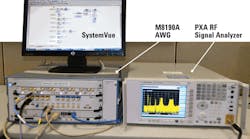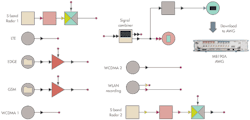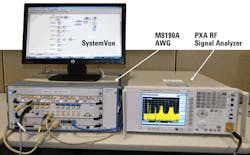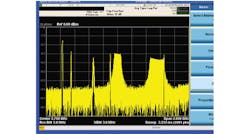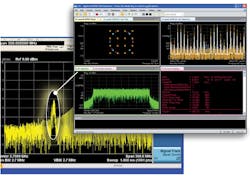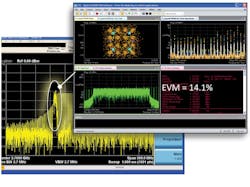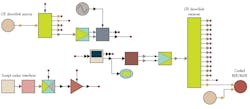This file type includes high resolution graphics and schematics when applicable.
Modern electronic systems operate in increasingly complex spectral environments, competing for available bandwidth. Many potential interference issues can occur between radar and wireless communications systems.1 For example, United States Navy ships must deal with a myriad of electronic systems, including radar and communications systems which can interfere with each other.2 The Navy is also investigating ship-based Long-Term-Evolution (LTE) wireless technology for close-quarters communications, adding even more complexity to these spectral environments.3 Investigating potential interference issues between complex wireless signals such as LTE and radar may be useful to ensure successful deployment.
A flexible means of evaluating systems in a research and development (R&D) laboratory should enable checking for co-existence issues before they are deployed. Such flexibility should support simulation of a wide range of different emitter signals and the capability to evaluate performance under different interference scenarios. Assessing the potential impact of radar interference on a wireless signal may involve evaluating key wireless performance metrics, such as error-vector-magnitude (EVM) and bit-error-rate (BER) performance or data throughput under a number of different interference scenarios.
A flexible R&D test solution can be created by combining design simulation with a precision arbitrary waveform generator (AWG) to create different interference scenarios. Several case studies are examined to show the flexibility of this approach. The first case study shows the test solution being used to create a multiemitter spectral environment consisting of an LTE emitter in the S frequency band; two S-band radar emitters; GSM, EDGE, and WCDMA emitters; and a WLAN emitter. Test equipment is used to evaluate the coexistence of an LTE and S-band radar emitter by evaluating LTE EVM performance in the presence of an interfering S-band radar emitter. The second case study evaluates simulated coded BER performance of an LTE downlink signal as an S-band radar interferer’s center frequency is swept.
The first case study focuses on an LTE downlink signal at S-band frequencies and an S-band radar signal, which are two of the emitters in a complex multi-emitter spectral environment, and how they can coexist within the same operating environment. The complex multi-emitter spectral environment is created using system-level design simulation which enables multiple wireless, wireless networking, and radar signals to be simulated and combined using commercial-off-the-shelf (COTS) simulation libraries. The multi-emitter signal (including the LTE downlink signal and S-band radar signal) is simulated with the schematic shown in Fig. 1. The S-band radar simulation signal source is shown at the top left, followed by the LTE downlink, EDGE, GSM, and WCDMA signal source. An additional S-band radar signal source and WCDMA signal source are also shown. A WLAN recording, which was captured using the Agilent 89600 VSA software, is read into the simulation environment as a simulation signal source.
Simulated signals with different center frequencies and bandwidths were resampled and combined together using a signal combiner element to create an output waveform which could then be downloaded to the precision AWG using a simulation sink element. Figure 2 shows the multi-emitter hardware test-equipment setup to evaluate LTE and radar coexistence, which includes a precision AXIe-based AWG (left), and an RF signal analyzer (right). The system-level simulator has been installed on the AXIe embedded controller (below the AWG) to create the multi-emitter test signals with the AWG.
This file type includes high resolution graphics and schematics when applicable.
Evaluating The Spectrum
This file type includes high resolution graphics and schematics when applicable.
Figure 3 shows the resulting multi-emitter test spectrum, which was measured with the RF signal analyzer. The multiemitter spectrum includes GSM, EDGE, and LTE emitters, two S-band radar emitters, and two WCDMA emitters. The LTE emitter and S-band radar emitter are shown near the center of the measured frequency spectrum.
The RF signal analyzer is used to measure the spectrum and EVM performance to evaluate the co-existence between the LTE source and radar emitter. Figure 4 shows the spectrum and demodulation results of the first scenario. The RF signal analyzer is used to zoom into the portion of the multi-emitter spectral environment which contains the LTE and radar emitters. The 89600 VSA software is applied to the RF signal analyzer to demodulate the LTE emitter. The 89600 VSA demodulation measurement shows the constellation (upper left), spectrum (lower left), EVM versus subcarrier (upper right), and EVM error summary (lower right).
The radar signal has some impact on the LTE signal in this scenario. The EVM is approximately 1.3% in the presence of the radar interferer, and the EVM versus subcarrier measurement shows performance degradation resulting from the radar interferer.
The LTE signal is set for a 5-MHz configuration, but can easily be varied for the many configurations supported by LTE, ranging from 1.4 to 20 MHz. The radar signal is configured for a linear-frequency-modulated (LFM) chirp with a user-specified pulse width, pulse repetition interval, and LFM chirp bandwidth. The settings can easily be modified by the user. Different modulation on pulse settings can also be configured (e.g., Barker coded).
For the second scenario, the radar signal was moved closer to the LTE signal (Fig. 5). The multi-emitter simulation was rerun to create the new test signal. The EVM demodulation results in Fig. 5 show that the radar signal has a more significant impact on the LTE signal in this scenario, relative to the first scenario. The EVM has degraded to approximately 14.1%, as a result of more spectral overlap with the radar spectrum. The EVM versus subcarrier measurement also shows additional performance degradation resulting from the radar interferer, relative to the first scenario.
The second case study examines the coexistence of an S-band radar system with an LTE wireless communications system by performing a simulation of LTE bit-error-rate (BER) performance as affected by interference from S-band radar signals. BER and throughput can be key metrics for receiver sensitivity, both with and without interferers present. The second case study employs the simulation schematic shown in Fig. 6 to evaluate the impact of an S-band radar interferer on simulated LTE downlink coded BER as the interferer’s center frequency is swept.
The schematic consists of an LTE downlink signal source on the upper left. This simulation signal source is hierarchical, so pushing down into it would reveal the physical layer coding applied to the signal, such as code-block segmenting, Turbo encoding, rate matching etc. This is not shown, however, in the top level schematic. Below the LTE downlink signal source is an LFM radar signal source. The center frequency of the LFM radar signal source will be swept for the LTE BER simulation. The LTE signal and radar signal are combined by a signal combiner element to resample and combine the two signals. The combined signal is then fed into the LTE receiver for the coded BER simulation measurement. The LTE receiver performs the physical layer decoding—code-block de-segmenting, Turbo decoding, rate dematching, and so forth—to recover the data bits so that coded BER and data throughput can be measured in simulation.
Figure 7 shows the LTE coded BER results as a function of the radar interferer’s center frequency, which was swept in the simulation. The LTE coded BER performance is significantly impacted as the radar interferer’s center frequency is swept across the LTE downlink frequency, increasing from a 0 % BER to approximately a 24 % BER. The LTE configuration, radar interferer configuration, and power levels can be varied to evaluate potential coexistence issues. An RF transmitter design and a receiver design with modeled design impairments could have also been evaluated as part of this simulation.
This file type includes high resolution graphics and schematics when applicable.
Conclusion
This file type includes high resolution graphics and schematics when applicable.
The article has illustrated a flexible approach in evaluating potential coexistence issues between wireless and radar signals in an R&D laboratory environment. The test solution combines a design simulation with a precision AWG to evaluate different interference scenarios. Design simulation is used to create a multi-emitter test signal spectrum which includes GSM, EDGE, and LTE emitters, as well as two S-band radar emitters, and two WCDMA emitters. The multi-emitter test signal is downloaded to a precision AWG to create a test signal environment to examine potential coexistence issues between LTE and radar emitters.
Several case studies are shown, including two scenarios which illustrates how an S-band radar interferer impacts LTE EVM performance and a simulation case study which illustrates how LTE coded BER performance is impacted by an S-band radar interferer as the interferer’s center frequency is swept. Although the case studies shown in this article utilize arbitrary signal scenarios to illustrate the flexibility of this solution, they highlight how potential coexistence issues could be evaluated in the R&D laboratory environment with user-defined signal scenarios.
Note: Mobile WiMAX is a registered trademark of the WiMAX Forum.
Greg Jue, Applications Development Engineer (Aerospace/Defense Applications)
Agilent Technologies, 5301 Stevens Creek Blvd., Santa Clara, CA 95051; (781) 860-5426, (800) 882-7426, FAX: (781) 860-5437.
References
1. David Leiss, “Military Radars and WLANs Wrestle with Interference Issues,” Agilent Technologies, RTC Magazine, November 2004.
2. “Spectrum monitoring for the fleet,” Naval Sea Systems Command.
3. “Navy plans ship-based LTE for close quarters communication,” Engadget, May 2012.
This file type includes high resolution graphics and schematics when applicable.
